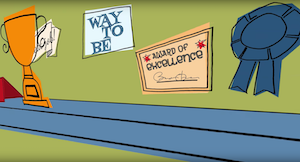
The issue is unavoidable: up to 20% of children struggle with mental health.
Worse, only 10-40% of the student population gets the mental health services they need. More than half say their school is their sole provider of service. And those who need it most are least likely to seek help.
Schools are doing the best with what they have. Still, responsibilities overlap, data goes unanalyzed, and students (or teachers) line up at overwhelmed counselors’ doors. How do schools address this issue—and who is responsible for mental health?
Look for the helpers
Here’s how the responsibilities break down in the average school district, though depending on size and spending, these roles may look different.Tier one care
All staff in school are responsible for connecting with students.Roles involved: Counselors, nurses, psychologists, social workers, teachers, all staff in school
In some districts, counselors create a core curriculum to give students a basic awareness of mental health. All staff members are also mandatory reporters of suspected abuse or unsafe conditions for children. Teachers in particular are the first line of defense: they interact with students most and can determine whether behavior is unusual. Mental health professionals will often call upon whomever the student trusts most.
“As far as services, a lot of times we really try to find who the child connects with,” says Tammy Stowers-Tonn, assistant special education director and school psychologist at the School District of Westfield in Wisconsin. “Whether it be a custodian, a lunch person, or a classroom teacher, we’ll find a particular go-to for a student.
Escalated cases: Intervention from specialists
The most overlap in mental healthcare responsibility occurs here.Roles involved: Counselors, nurses, school social workers, school psychologists
Psychologists, social workers, counselors, and nurses are trained to identify warning signs. They also take part in developing individual intervention plans (including individual education programs), making referrals to specialists inside and outside of school, and maintaining confidentiality.
From there, the responsibilities begin to diverge. Pupil services staff (such as school psychologists, school social workers, counselors, and nurses) focus on screening for specific illnesses, as well as training staff to recognize when a referral is appropriate. Counselors and social workers take on outreach to support teams, which take many forms and are unique to each student. These teams often include parents, school and clinical psychologists, counselors, and social workers.
“Most of the time, teachers will sit on the coordinated services team too,” Stacey Oliphant, who is the school social worker at Westfield, explains. Coordinated services teams are one example of state-funded services available in Wisconsin.
Triage: Keep kids in classrooms
Education-based, not medical intervention.Roles involved: Psychologist, social worker
Once the need for intense intervention is established, school psychologists and social workers step in. Psychologists may counsel students if time permits, but they’re not therapists—their aim is to get kids back into the classroom to learn. Psychologists determine whether students need special education status for behavior or academics. They work on IEPs, provide outreach to support teams, and make referrals to specialists inside and outside of school. Research shows these and other duties impact the outcomes of students and schools.
School social workers serve as liaisons to families, serve on support teams, and make referrals to specialists outside of school. Their services are available to students regardless of intervention status or special needs.
Who helps the helpers?
Across the spectrum of intervention, duties overlap a great deal, giving kids multiple ways to get help and forming dedicated teams to create and support personalized interventions. Detailed communication is crucial when determining whether a student already has a care plan or previous intervention.“There’s a lot of ongoing consultation—a lot!” says Oliphant.
“If I get an email from a teacher, my first call is to Stacey. I want to make sure I’m not intervening on something that’s already in process,” Stowers-Tonn explains. “We also take turns on teams.”
Annual training from mental health teams takes place within the district, with school social workers, counselors, and nurses training staff. Smaller districts may make do with a team of traveling counselors or nurses and may not even have a social worker on staff.
“We see kids as early as five years old who are struggling,” Stowers-Tonn says. “We need as many hands-on, trained people as we can to help.”
Funding & data
Districts often rely on grant money to fund mental health initiatives. In some states, recent grant programs for school safety have extended funds for mental health outreach as well.Westfield is hoping for such a grant to fund a new screener, which can be delivered by counselors or psychologists. “I’m hoping to move forward with having a screener in the district, so kids can be identified sooner,” Stowers-Tonn explains.
After grant money runs out, districts must choose whether or not to continue programs using existing funds. In Stacey Oliphant’s case, Westfield saw the value in keeping a school social worker to keep truancy to a minimum and provide outreach to families. Counties also use municipal grant money to fund mental health professionals visiting schools.
Some specific grants fund surveys and other methods of gathering data. Occasionally due to lack of time the data may not be analyzed. Westfield has created data-driven programs for elementary students based on surveys of older students’ mental health and substance abuse, even producing t-shirts with positive stats printed on them for teachers to wear. The upcoming population benefits from proactive outreach based on the current population’s challenges.
The growing teacher mental health crisis
Over half of teachers in the United Kingdom report poor mental health, and a staggering 80% say mental health affects relationships with students. In the United States, the National Union of Teachers also reported 55% of teachers indicating low or very low morale.It’s not getting better. In fact, an American Federation of Teachers survey asked, “For how many days during the past 30 days was your mental health not good?” In 2014, 10% of responders said 11+. In 2017, the number jumped to 21%.
As teachers struggle with their own health, their ability to connect and monitor students’ behavior suffers. They may vent frustrations to school psychologists, who can make recommendations to seek clinical help. The process is more nebulous than student referrals.
"When a teacher who is struggling with an issue chooses to come to me, I can offer them support, guidance, and resources," Oliphant explains. "If I think it warrants more intense support, I can refer them to a clinical therapist."
The solution?
As with so many struggles, the mental health crisis is bigger than schools and districts. It’s also likely to remain hidden as students and adults suffer in silence.The important work described here is just the beginning. Students and staff who personally struggle with mental health face daily battles. The mental health professionals in schools are working tirelessly to help people tackle those challenges and make incremental steps toward achieving a more functional and comfortable life.
When it comes to mental health, pin hope on making progress rather than achieving perfection.
Follow-up Resource: Counselors' Invaluable Impact
Explore the wide range of duties they take on each day in The New Role of the School Counselor.WHAT'S NEXT FOR YOUR EDTECH? The right combo of tools & support retains staff and serves students better. We'd love to help. Visit skyward.com/get-started to learn more.

|
Erin Werra Blogger, Researcher, and Edvocate |
Erin Werra is a content writer and strategist at Skyward’s Advancing K12 blog. Her writing about K12 edtech, data, security, social-emotional learning, and leadership has appeared in THE Journal, District Administration, eSchool News, and more. She enjoys puzzling over details to make K12 edtech info accessible for all. Outside of edtech, she’s waxing poetic about motherhood, personality traits, and self-growth.




